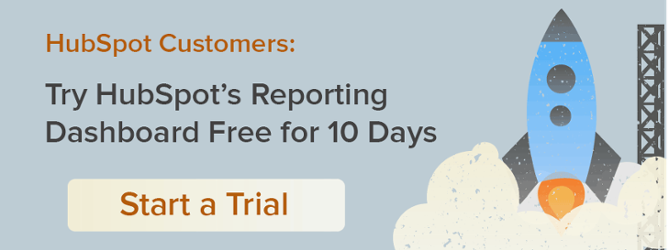Have you ever been stuck in traffic on a long road trip when suddenly your GPS notifies you that there is now a faster route available to reach your end destination in less time?
With GPS apps like Waze and Google Maps, we are constantly sharing information that allows these apps to report on current traffic patterns and predict future traffic patterns. This allows us to complete our journey in the least amount of time, thanks to the information on the communities past journeys.
Closed-loop reporting provides the same type of predictability for marketers as new visitors on your site go through their journey to potentially becoming your customer. While no two customer journeys are identical and there may be pit-stops and detours along the way, closed-loop reporting will give you the insights into future customer journeys.
If you are currently using HubSpot for your inbound marketing with the goal of acquiring customers, new students or donors, closed-loop reporting is arguably the best crystal ball to have in your inbound marketing arsenal. In this post, we'll define closed-loop reporting and look at ways it can help you be more successful as a marketer.
What is closed-loop reporting?
At the most simplistic level, closed-loop reporting shows you each interaction a customer had on your website from the first time they visited your site through to becoming a customer. The graphic below further illustrates the closed loop reporting process.
Now let's take a look at a simplified customer timeline to get a feel for what you can expect closed-loop reporting to look like for an individual contact record inside of HubSpot. Keep in mind, the length of your marketing and sales cycle will dictate the length of the timeline and the number of touch points a contact has with your organization prior to becoming a customer.
The information closed-loop reporting provides for an individual customer timeline is interesting and provides helpful insights to the sales team. The true power of closed-loop reporting lies in the aggregation of many customer journeys through your organizations marketing and sales funnel.
How to use closed-loop reporting
Setting up close loop reporting will allow you to make more accurate, strategic decisions in many areas of your marketing. Unfortunately, many inbound marketers find themselves staring at a row of zeros under their customer column in their sources report.
Let's take a look at how closed-loop reporting can significantly increase the quality of decision making as a marketer. We will use a common scenario any marketer focused on attracting visitors, converting visitors to leads with the end goal of closing contacts to customers faces.
Looking at the information in the sources graph below, which three traffic sources would you identify as being most effective at achieving your end goal of closing customer?
With the limited data, the top three are fairly easy to identify as you have to focus on number of contacts and visit to contact conversion rate.
- Direct Traffic has generated 392 contacts at a visit to contact conversion rate of 5.2%
- Organic Search has generated 150 contacts at a visit to contact conversion rate of 2.3%
- Email Marketing has generated 54 contacts at a visit to contact conversion rate of 5.9%
With the lack of closed-loop reporting data available to you as a marketer, there is a good chance you will prioritize increasing traffic from your top performing sources based on visits and leads data. Unfortunately, you may be heading down the wrong path without even knowing it, because you lack insights from your end goal: customers.
Taking a look at the Sources Report below that now includes the closed-loop reporting data, would you change the list of top three most effective traffic sources at generating customers?
With the customer data at hand, does your reordered list look similar to this?
- Social Media generated 20 customers at a 76.9% contact to customer conversion rate
- Referrals generated 4 customers at a 19.4%
- Direct Traffic generated 15 customers at a 3.8% conversion rate
This is just the beginning of the insights closed-loop reporting will provide you as a marketer. As you dig into each individual traffic source, you will be faced with the same dilemma of having to make decisions on where to focus your marketing resources. Without closed-loop reporting, you will be forced to make decisions from the vantage point of just visits and leads data versus the holistic vantage point you get from closed-loop reporting to make decisions based on visits, leads and customer data.
Let's now dig into the social media traffic source to identify which social networks are resulting the great contact to customer conversion rate we identified above. Based off the sources graph below, which three social networks would you focus your social media efforts on if your goal is to attract visitors, converting them to leads and close as many of the leads into customers as possible?
Without the closed-loop reporting data would you have come to the same conclusion?
The insights that closed-loop reporting provides for identifying which traffic sources to focus on is just the tip of the iceberg when it comes to the power that this kind of reporting will provide you as a marketer.
Here are a few additional benefits worth highlighting found in this HubSpot blog post:
- Deliver clearer results to your boss
- Gain insights about your personas based off their activities on your site
- Shorten your sales cycle by identifying which pages viewed and content consumed increases the chances of the lead closing to a customer
- Set the right goals and expectations
- Keep your Cost-per-Lead Low
If you do not yet have closed-loop reporting set-up, you have a crystal ball within reach. Use your data as a way to predict future behaviors based on past visits, contacts and customer behaviors.
There are a few typical ways fellow inbound marketers go about implementing closed-loop reporting:
- Integrate your CRM with HubSpot (Knowledge article)
- Import a list of new customers on a monthly basis
- Each time your company closes a new customer, manually mark off a lead as a customer on the contact record.
For those of you reading this post who already have closed-loop reporting implemented at your organization, please share some of the benefits closed-loop reporting has provided you and your organization in the comments below.
Happy closed-loop reporting!

















